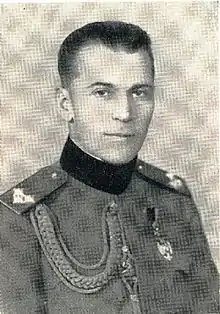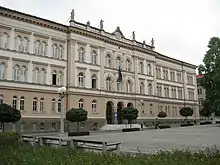Vladimir Vauhnik
Vladimir Vauhnik (1896—1955) was Yugoslav military officer of Slovenian extraction.[1] Vauhnik is most notable for his Counterintelligence activities before and during World War II that could have changed the course of the war.[2]
Vladimir Vauhnik | |
|---|---|
 Vauhnik in 1920's | |
| Born | June 24, 1896 Svetinje, Austria-Hungary |
| Died | March 31, 1955 (aged 58) Buenos Aires, Argentina |
| Allegiance | |
| Rank |
|
| Battles/wars | |
Early life

Vauhnik was born on 24 June 1896 in Svetinje, Austria-Hungary (modern-day Slovenia). His parents were teachers. Vauhnik completed First Gymnasium in Maribor and Austrian cadet military school.[3] After the World War I Vauhnik returned to newly established Yugoslavia and participated in the Austro-Slovene conflict in Carinthia. He was decorated by Yugoslav authorities for his bravery in this conflict and promoted to the rank of Captain.[4]
Prelude to World War II
Vauhnik was probably the first in the world who presented information that the Nazi Germany would invade Poland and Yugoslavia and later Soviet Union, based on the covert and legal methods he used.[5]
Based on the orders of Milan Nedić, who was Minister of Defence of the Kingdom of Yugoslavia, Vauhnik visited German supreme command twice, to secure Yugoslav interest in the port of Thessaloniki.[6]
His colleagues during military education in École spéciale militaire de Saint-Cyr in France included Draža Mihailović.[7]
During the World War II
Before the outbreak of the World War II Vauhnik had the rank of Colonelon the position of Yugoslav military attache in Berlin where he closely cooperated with Ivo Andrić.[8]
According to his testimony, already on 14 March 1941 Vauhnik had "irrefutable proof and even fairly detailed plans" about the initiation of preparations for attacks on Soviet Union by German forces.[9] Vauhnik also emphasized that government of the United Kingdom was informed about those plans.[10]
After Axis invasion of Yugoslavia, Vauhnik was captured in Belgrade and transported to Berlin at the beginning of May 1941 where he was interrogated in Reich Main Security Office.[11] He was released as German citizen because he was born in part of Yugoslavia which was annexed by Germany at that time.[12] After his release Vauhnik went to Ljubljana.[13]
In 1942 Vauhnik forged a plan to transport King Peter II of Yugoslavia to Axis occupied Yugoslavia to mobilize Serbs and Croats under his command.[14] His plan was based on the fact that German forces were entingled on Eastern Front while Italians could be convinced not to interfere.[15]
Vauhnik was coworker of Ivan Prezelj, commander of Slovenian Chetniks (Blue Guard).[16] Vauhnik was initiator for establishment of the Military Council of all Slovene liberal political movements (Slovene: Zveza). Vauhnik was at that time on the position of acting commander of the Headquarter of the Chetniks in Slovenia.[17] In 1944 Draža Mihailović promoted Vauhnik to rank of Brigadier General.[18] According to Chetnik voivode Šušterič, Vauhnik and Mihailović were blood brothers.[19]
According to some sources, Vauhnik travelled to Switzerland in June 1944 to offer to put Slovenian domobranci, some soldiers of Independent State of Croatia and some Chetnik units under British command.[20] His offer was rejected by the British representatives.[21]
After World War II
After World War II Vauhnik went to Buenos Aires in Argentina where he lived quiet life without joining any of numerous Yugoslav emigrant political groups.[22] Vauhnik died on 31 May 1955 in Buenos Aires, Argentina[23]
Bibliography
Works of Vladimir Vauhnik include:
- Vauhnik, Vladimir (1967). Memoiren eines Militärattachés: (Ein Kampf gegen das Fingerspitzengefühl Hitlers) [Mit Abbildungen, Diagramm, und Karten-Skizze]. Editorial Palabra Eslovena.CS1 maint: ref=harv (link)
- Vauhnik, Vladimir (1972). Nevidna fronta. Delo.CS1 maint: ref=harv (link)
- Krizman, Bogdan (1986). Pavelić u bjekstvu. Globus.CS1 maint: ref=harv (link)
References
- (Podbregar & Ivanusa 2016, p. 142)
- (Podbregar & Ivanusa 2016, p. 142)
- (Лесковац, Форишковић & Попов 2004, p. 104): "Ваухник, Владимир. официр, обавештајац, вој- ни аташе (Светиње, Словенија, 24. VI 1896 — Аргентина, 31. III 1955) Рођен је у наставничкој породици. У Марибо- ру је завршио гимназију и аустријску Кадетску "
- (Rahten 2009, p. 176)
- (Podbregar & Ivanusa 2016, p. 142)
- (Trifković 1998, p. 91)
- (Dimitriǰević & Nikolić 2004, p. 59)
- (Mitić 2002, p. 135): "АндриЬев сарадник на том послу у посланству, во]гт аташе, пуковник Владимир Ваухник"
- (Zalar 1961, p. 59)
- (Zalar 1961, p. 59)
- (Vojinović 1988, p. 76)
- (Vojinović 1988, p. 76)
- (Vojinović 1988, p. 76)
- (Jukić 1974, p. 128): "Colonel Vladimir Vauhnik, the Yugoslav military attache" in Berlin, described to me how he worked out a plan in 1942 to send King Peter to Yugoslavia so that Serbs and Croats might rally under his leadership."
- (Jukić 1974, p. 128)
- (Bevc 2007, p. 191)
- Vojno-istoriski glasnik (in Serbian). 1983. p. 183. Retrieved 19 January 2019.
Inicijativu za obrazovanje Saveta dao je general Vladimir Vauhnik, kasnije vršilac dužnosti komandanta Komande „Kraljevske jugoslovenske vojske u Sloveniji” (čiji je komandant tada bio pukovnik Ivan Prezelj.
- (Podbregar & Ivanusa 2016, p. 143)
- Šušterič, Uroš (12 February 2011). "Vojvoda iz Dežele još odan Draži" (in Serbian). Večernje Novosti. Retrieved 29 January 2019.
Nju je vodio Čičin pobratim, general Vladimir Vauhnik, generalštabni pukovnik, vojni ataše Kraljevine Jugoslavije u Berlinu.
- (Sirc 1989, p. 45): "It appears that in June 1944, Colonel Vauhnik had come to Switzerland to offer the services of the Slovene Domobranci, of some Croat soldiers and some Chetniks to the British. "
- (Sirc 1989, p. 45): "And it also appears that he was unceremoniously turned down."
- (Krizman 1986, p. 225)
- (Podbregar & Ivanusa 2016, p. 143)
Sources
- Podbregar, Iztok; Ivanusa, Teodora (6 December 2016). The Anatomy of Counterintelligence: European Perspective. Bentham Science Publishers. ISBN 978-1-68108-411-4.CS1 maint: ref=harv (link)
- Zalar, Charles (1961). Yugoslav Communism: A Critical Study. U.S.GovernmentPrint.Office.CS1 maint: ref=harv (link)
- Jukić, Ilija (1974). The fall of Yugoslavia. Harcourt Brace Jovanovich.CS1 maint: ref=harv (link)
- Dimitriǰević, Boǰan; Nikolić, Kosta (2004). Đeneral Mihailović: biografija. Институт за савремену историју (Belgrade, Serbia).CS1 maint: ref=harv (link)
- Trifković, Srdja (1998). Ustaša: Croatian separatism and european politics 1929-1945. The Lord Byron Foundation for Balkan Studies.CS1 maint: ref=harv (link)
- Mitić, Miodrag (2002). Poete u fraku. "Filip Višnjić".CS1 maint: ref=harv (link)
- Bevc, Vladislav (2007). Liberal Forces in Twentieth Century Yugoslavia: Memoirs of Ladislav Bevc. Peter Lang. ISBN 978-1-4331-0008-6.CS1 maint: ref=harv (link)
- Sirc, Ljubo (1989). Between Hitler and Tito: Nazi Occupation and Communist Oppression. André Deutsch. ISBN 978-0-233-98405-6.CS1 maint: ref=harv (link)
- Vojinović, Aleksandar (1988). Leon Rupnik. Centar za informacije i publicitet. ISBN 978-86-7125-030-6.CS1 maint: ref=harv (link)
- Rahten, Andrej (2009). Nova slovenska biografija. Založba ZRC, ZRC SAZU. ISBN 978-961-254-131-6.CS1 maint: ref=harv (link)
- Лесковац, Младен; Форишковић, Александар; Попов, Чедомир (2004). Српски биографски речник. Будућност.CS1 maint: ref=harv (link)